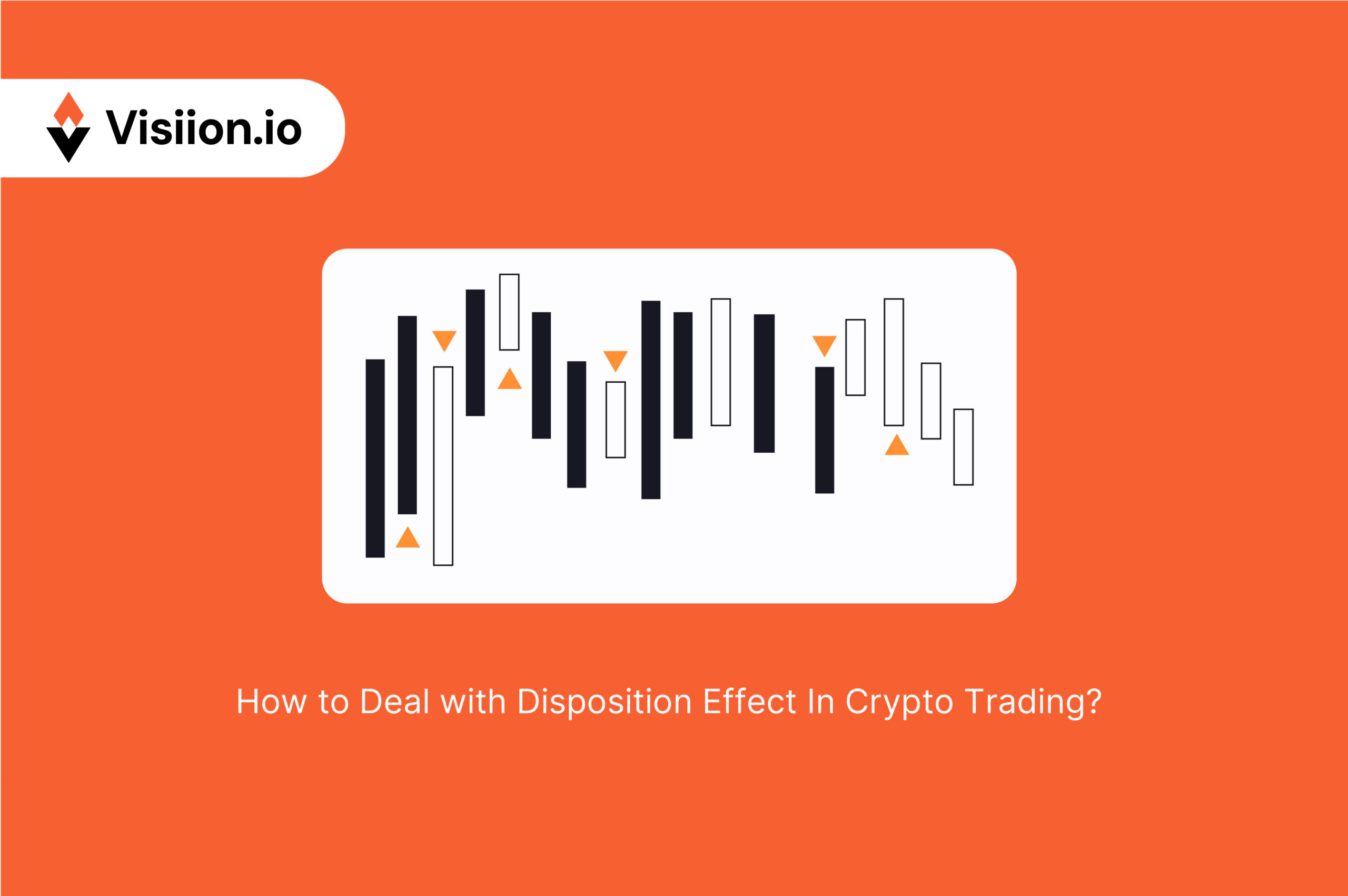How to Deal with Disposition Effect In Crypto Trading?
TL;DR
The disposition effect causes traders to sell winning assets too soon while holding onto losing positions too long. This behavior stems from emotional bias, not logic. When you have understood this effect, you might avoid big and expensive mistakes. And when you are trading in the crypto market, there is no room for such costly mistakes. In this piece, we will break down the core psychology behind the disposition effect, how it impacts the actual trade outcome, and how pro-traders avoid it.
This pattern is even more visible in the crypto market. The primary reason is the volatility and non-stop nature of the market. Inexperienced (and sometimes, even experienced) traders have a fear, “What if this asset might drop again after going a little bit above my entry?”
And this fear leads to early profit booking. While it might appear to be a rational decision at a glance, most of these decisions stem from emotions. And when it comes to trading, emotion kills. On the contrary, people keep holding their losing trade with “hope.”
Over time, this behavior shapes portfolios—small gains banked too soon, larger losses left to grow. This behavioral pattern is what economists call the disposition effect.
In this blog, we will take a look at this effect and how it impacts trading and overall profitability over the long run. So let’s get started
What Is the Disposition Effect?
The disposition effect refers to a behavioral bias where traders sell assets that have gained value quickly but hesitate to sell those that have dropped in price. They feel satisfaction when they book a profit and discomfort when they lock in a loss. So, they act against their own long-term financial interest.
This happens across all markets—stocks, futures, and crypto. In crypto, the emotional trigger multiplies. The 24/7 markets, the speed of movement, and the hype cycles make the bias even harder to fight.
Why Some Traders Fall Into This Trap?
Most traders want to avoid the pain of loss more than they want to enjoy the joy of profit. That mindset drives the disposition effect. Selling a winner validates your decision. Holding a loser keeps hope alive that the price will bounce back, and you won’t have to admit the mistake.
You might look at a coin you bought at $80 that is now down to $50 and think, “I’ll wait until it gets back to my entry.” That wait often costs you more, and it ties up capital that could earn better returns elsewhere.
When prices fall, hope replaces discipline. When prices rise, fear of missing out on gains makes you close early. That imbalance feeds the cycle.
The Psychology Behind It
The disposition effect sits at the intersection of loss aversion and mental accounting. Traders compartmentalize each position emotionally. They don’t treat the whole portfolio as one. They separate “winners” from “losers” and start attaching emotions to them.
The brain hates red numbers. Seeing unrealized losses on your dashboard feels like a failure, even though it isn’t locked in until sold. So, the brain waits. It hopes. It delays. On the flip side, when it sees green numbers, it wants the quick dopamine shot of clicking “Sell” and saying, “I was right.”
This irrational behavior gives the illusion of control. It tricks traders into thinking they’re actively managing risk. In reality, they’re emotionally reacting to price movement.
How the Disposition Effect Affects Crypto Traders?
Crypto traders suffer more because crypto moves faster than traditional markets. A coin can pump 30% in an hour and crash 60% in a day. So it’s obvious that emotions run hot; news spreads fast here. On top of this, social media fuels the fire here.
When a coin jumps from $1 to $1.30, many traders sell it instantly just to “book profits.” But when it drops from $1.30 to $0.80, they hold, waiting for it to recover. Some even double down, throwing good money after bad.
This behavior wrecks the portfolio over time. It leads to a trail of small wins and massive losses. Instead of compounding capital, the trader keeps spinning in circles—happy with wins, trapped in losses.
For e.g.
Let’s say you buy $10,000 worth of a token at $2. The price jumps to $2.60. You sell, and you feel smart as you banked 30%.
Now, you can buy another token for $5. But it drops to $3.70, and you tell yourself it’ll recover. For this, you hold it for a long time. The coin keeps dropping further, and you do not cut losses because you do not want to book losses. And this causes you even more losses.
Eventually, that token drops so low that there is an almost negligible chance that you’ll recover your investment. Your unrealized loss becomes permanent. You earned $3,000 on the first coin but lost $6,300 on the second. And you repeat the cycle again next time because the bias hides in your thinking.
Why It’s Dangerous to Hold Losers?
Holding losers doesn’t just affect the current trade. It eats into your future opportunities. You tie up capital in underperforming assets. You miss out on trades that could deliver real growth.
It also skews your judgment. You keep checking that losing trade, hoping for a miracle. You avoid analyzing better coins and feel guilty about missing pumps because you’re stuck with a bag.
Every moment you hold a loss to “wait for recovery,” you’re giving up the chance to build momentum elsewhere. Crypto doesn’t wait, and hence, your capital shouldn’t either.
How to Beat the Disposition Effect?
Now, this is the trickiest part. You can’t remove the bias entirely, and pro traders understand this. So what they do is they train their mind to override it. You can do the same. The first step of awareness is to recognize the pattern in your trades. Look at your past portfolio and count how many times you sold winners too early. Once done, check how long you held the losers.
Once you spot the pattern, build a rule-based system. Set target exits before you enter the trade. Define both stop-loss and take-profit zones. Stick to them, even when emotions scream otherwise.
Use trailing stops if you’re unsure when to exit a winner. That way, you ride gains but protect downside.
Finally, log every trade. Document your reason for entering and exiting and your emotional state. That data gives you a mirror, and you’ll start catching yourself before you repeat mistakes.
When the Disposition Effect Feels Logical (But Isn’t)?
Sometimes, traders justify holding losers by citing fundamentals. They say, “The project is solid,” or “They’re launching a new feature next quarter.” But the market doesn’t reward good tech—it rewards perceived momentum.
If your thesis fails, exit. Don’t wait for fundamentals to catch up to your entry price. Price action reflects collective belief, not your individual conviction.
A good asset bought at the wrong time becomes a bad trade. Period.
The Role of Social Proof
When traders see others celebrating profits on Twitter or Telegram, they feel left out. This intensifies the need to sell winners fast and just to “lock in” some success. At the same time, nobody wants to admit they’re holding a loser. So, they hide and stop talking about it. They wait in silence, hoping their pick will somehow shoot up over the longer run.
This social silence makes the loss feel more personal. That emotional weight delays exit even further, and the cycle feeds itself.
Disconnect from the crowd when making decisions. Price charts don’t care about social media. Neither should your strategy.
Use Technology To Stay Objective
Modern crypto platforms offer tools that can help you stay disciplined. For example, if you are using Visiion.io, you can set automated sell triggers or use conditional orders. This makes sure that your system exits your position if it drops below a threshold. You can remove your emotions from the execution process.
Remember, the more you automate risk control, the less power the disposition effect holds over your trading behavior.
Wrapping Up
Look, there is no way we, as humans, can eliminate emotions entirely from our trading. But what pro-traders do is to have a solid trading setup. Instead of relying solely on themselves, they use features like stopping losses and taking profits from reliable crypto platforms like Visiion.io. This reduces the emotional intervention a lot. When they do this, they eliminate the risk of emotional decisions. And this is the most critical aspect when you are trading in the crypto market. The inherent volatility of the crypto market requires control over thoughts, emotions, and trade.
Train your mind. Trust your strategy. Remember, the important quality of top traders is not to avoid wrong entries but to cut them quickly.










